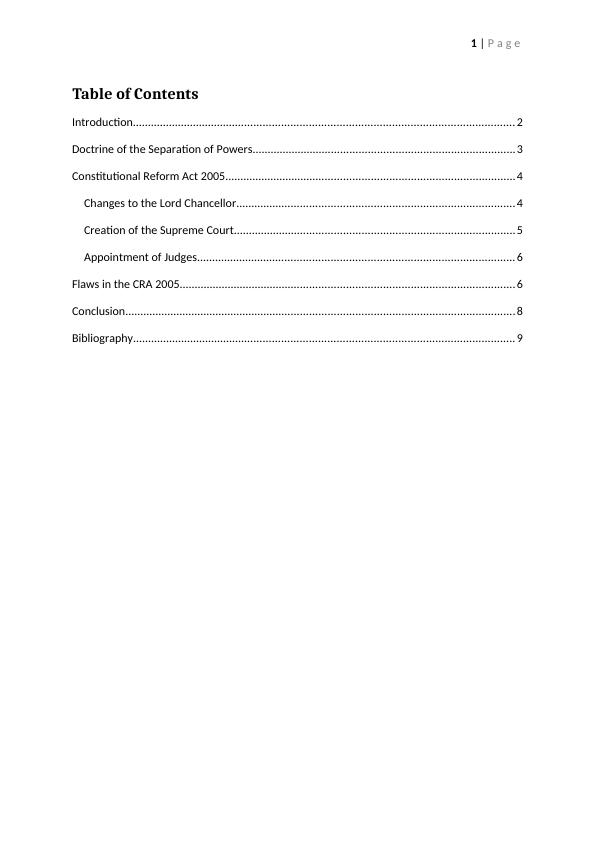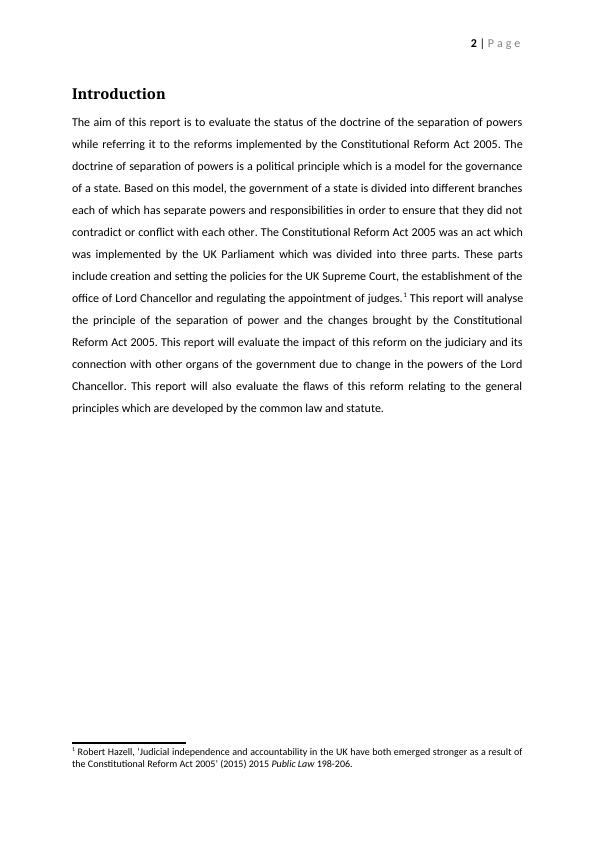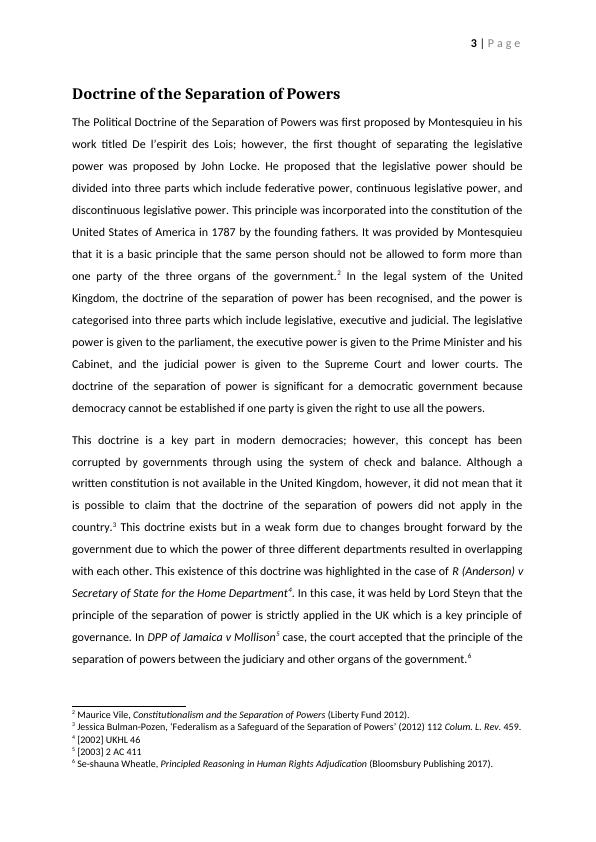Doctrine of Separation of Powers and Constitutional Reform Act 2005
Added on 2023-06-01
11 Pages3044 Words65 Views
0 | P a g e
Public Law
Public Law

1 | P a g e
Table of Contents
Introduction............................................................................................................................. 2
Doctrine of the Separation of Powers......................................................................................3
Constitutional Reform Act 2005...............................................................................................4
Changes to the Lord Chancellor........................................................................................... 4
Creation of the Supreme Court............................................................................................5
Appointment of Judges........................................................................................................ 6
Flaws in the CRA 2005..............................................................................................................6
Conclusion................................................................................................................................ 8
Bibliography............................................................................................................................. 9
Table of Contents
Introduction............................................................................................................................. 2
Doctrine of the Separation of Powers......................................................................................3
Constitutional Reform Act 2005...............................................................................................4
Changes to the Lord Chancellor........................................................................................... 4
Creation of the Supreme Court............................................................................................5
Appointment of Judges........................................................................................................ 6
Flaws in the CRA 2005..............................................................................................................6
Conclusion................................................................................................................................ 8
Bibliography............................................................................................................................. 9

2 | P a g e
Introduction
The aim of this report is to evaluate the status of the doctrine of the separation of powers
while referring it to the reforms implemented by the Constitutional Reform Act 2005. The
doctrine of separation of powers is a political principle which is a model for the governance
of a state. Based on this model, the government of a state is divided into different branches
each of which has separate powers and responsibilities in order to ensure that they did not
contradict or conflict with each other. The Constitutional Reform Act 2005 was an act which
was implemented by the UK Parliament which was divided into three parts. These parts
include creation and setting the policies for the UK Supreme Court, the establishment of the
office of Lord Chancellor and regulating the appointment of judges.1 This report will analyse
the principle of the separation of power and the changes brought by the Constitutional
Reform Act 2005. This report will evaluate the impact of this reform on the judiciary and its
connection with other organs of the government due to change in the powers of the Lord
Chancellor. This report will also evaluate the flaws of this reform relating to the general
principles which are developed by the common law and statute.
1 Robert Hazell, ‘Judicial independence and accountability in the UK have both emerged stronger as a result of
the Constitutional Reform Act 2005’ (2015) 2015 Public Law 198-206.
Introduction
The aim of this report is to evaluate the status of the doctrine of the separation of powers
while referring it to the reforms implemented by the Constitutional Reform Act 2005. The
doctrine of separation of powers is a political principle which is a model for the governance
of a state. Based on this model, the government of a state is divided into different branches
each of which has separate powers and responsibilities in order to ensure that they did not
contradict or conflict with each other. The Constitutional Reform Act 2005 was an act which
was implemented by the UK Parliament which was divided into three parts. These parts
include creation and setting the policies for the UK Supreme Court, the establishment of the
office of Lord Chancellor and regulating the appointment of judges.1 This report will analyse
the principle of the separation of power and the changes brought by the Constitutional
Reform Act 2005. This report will evaluate the impact of this reform on the judiciary and its
connection with other organs of the government due to change in the powers of the Lord
Chancellor. This report will also evaluate the flaws of this reform relating to the general
principles which are developed by the common law and statute.
1 Robert Hazell, ‘Judicial independence and accountability in the UK have both emerged stronger as a result of
the Constitutional Reform Act 2005’ (2015) 2015 Public Law 198-206.

3 | P a g e
Doctrine of the Separation of Powers
The Political Doctrine of the Separation of Powers was first proposed by Montesquieu in his
work titled De l’espirit des Lois; however, the first thought of separating the legislative
power was proposed by John Locke. He proposed that the legislative power should be
divided into three parts which include federative power, continuous legislative power, and
discontinuous legislative power. This principle was incorporated into the constitution of the
United States of America in 1787 by the founding fathers. It was provided by Montesquieu
that it is a basic principle that the same person should not be allowed to form more than
one party of the three organs of the government.2 In the legal system of the United
Kingdom, the doctrine of the separation of power has been recognised, and the power is
categorised into three parts which include legislative, executive and judicial. The legislative
power is given to the parliament, the executive power is given to the Prime Minister and his
Cabinet, and the judicial power is given to the Supreme Court and lower courts. The
doctrine of the separation of power is significant for a democratic government because
democracy cannot be established if one party is given the right to use all the powers.
This doctrine is a key part in modern democracies; however, this concept has been
corrupted by governments through using the system of check and balance. Although a
written constitution is not available in the United Kingdom, however, it did not mean that it
is possible to claim that the doctrine of the separation of powers did not apply in the
country.3 This doctrine exists but in a weak form due to changes brought forward by the
government due to which the power of three different departments resulted in overlapping
with each other. This existence of this doctrine was highlighted in the case of R (Anderson) v
Secretary of State for the Home Department4. In this case, it was held by Lord Steyn that the
principle of the separation of power is strictly applied in the UK which is a key principle of
governance. In DPP of Jamaica v Mollison5 case, the court accepted that the principle of the
separation of powers between the judiciary and other organs of the government.6
2 Maurice Vile, Constitutionalism and the Separation of Powers (Liberty Fund 2012).
3 Jessica Bulman-Pozen, ‘Federalism as a Safeguard of the Separation of Powers’ (2012) 112 Colum. L. Rev. 459.
4 [2002] UKHL 46
5 [2003] 2 AC 411
6 Se-shauna Wheatle, Principled Reasoning in Human Rights Adjudication (Bloomsbury Publishing 2017).
Doctrine of the Separation of Powers
The Political Doctrine of the Separation of Powers was first proposed by Montesquieu in his
work titled De l’espirit des Lois; however, the first thought of separating the legislative
power was proposed by John Locke. He proposed that the legislative power should be
divided into three parts which include federative power, continuous legislative power, and
discontinuous legislative power. This principle was incorporated into the constitution of the
United States of America in 1787 by the founding fathers. It was provided by Montesquieu
that it is a basic principle that the same person should not be allowed to form more than
one party of the three organs of the government.2 In the legal system of the United
Kingdom, the doctrine of the separation of power has been recognised, and the power is
categorised into three parts which include legislative, executive and judicial. The legislative
power is given to the parliament, the executive power is given to the Prime Minister and his
Cabinet, and the judicial power is given to the Supreme Court and lower courts. The
doctrine of the separation of power is significant for a democratic government because
democracy cannot be established if one party is given the right to use all the powers.
This doctrine is a key part in modern democracies; however, this concept has been
corrupted by governments through using the system of check and balance. Although a
written constitution is not available in the United Kingdom, however, it did not mean that it
is possible to claim that the doctrine of the separation of powers did not apply in the
country.3 This doctrine exists but in a weak form due to changes brought forward by the
government due to which the power of three different departments resulted in overlapping
with each other. This existence of this doctrine was highlighted in the case of R (Anderson) v
Secretary of State for the Home Department4. In this case, it was held by Lord Steyn that the
principle of the separation of power is strictly applied in the UK which is a key principle of
governance. In DPP of Jamaica v Mollison5 case, the court accepted that the principle of the
separation of powers between the judiciary and other organs of the government.6
2 Maurice Vile, Constitutionalism and the Separation of Powers (Liberty Fund 2012).
3 Jessica Bulman-Pozen, ‘Federalism as a Safeguard of the Separation of Powers’ (2012) 112 Colum. L. Rev. 459.
4 [2002] UKHL 46
5 [2003] 2 AC 411
6 Se-shauna Wheatle, Principled Reasoning in Human Rights Adjudication (Bloomsbury Publishing 2017).

End of preview
Want to access all the pages? Upload your documents or become a member.
Related Documents
Doctrine of Separation of Powerslg...
|3
|785
|49
Constitutional Reformlg...
|10
|3236
|65
Introduction To Business Law (docs)lg...
|13
|3146
|249
Separation of Powers in Australia: Extent and Sufficiencylg...
|22
|6837
|231
Changes in Judicial Appointment Process in England and Waleslg...
|9
|2811
|81
Role and Importance of Juries in the English Criminal Legal Systemlg...
|6
|1296
|38
